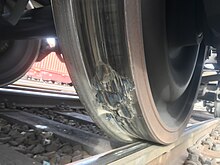Flat spot
A flat spot is an undesirable phenomenon of wear on the wheels of rail vehicles .
Emergence
A flat spot occurs when the wheel of the moving vehicle no longer rolls, but slides over the track . This phenomenon is also called sliding . This can be caused either by an undetected firm brake , by a normal braking process in which the adhesion between the track and the wheel is not high enough, or by an excessive braking process (e.g. in the case of rapid braking ). Devices such as anti-skid protection or the sand spreader are intended to prevent sliding. Since the wheel is made of a softer alloy ( X2CrNi12 ) than the rail to protect the rails , the material is worn off at the point on the wheel where the wheel slides on the rail. In addition to the wheel, the rail is also worn out, but this wear and tear on the rail is minimal, since the blocked wheel slides over the rail and it thus wears relatively evenly. In contrast to this, the contact surface remains on the wheel and there is uneven wear on the wheel itself (the rail sliding beneath it acts like a grinding belt on the stationary wheel). As a result, a flat spot forms on the wheel tread, which is not infrequently annealed due to the high temperature development. In addition, so-called deposits can also occur. This material, which is sanded off the rail surface and usually applied directly in front of the flat spot, or also at another point, can in the worst case lead to the wheels locking because the brake blocks can become jammed in it.
consequences
If the flat spot is small enough, the vehicle can continue driving without restrictions. During the journey, a noise that occurs periodically at the frequency of the wheel rotation can be heard. The affected wheelset is then turned off again on a wheelset lathe during the next maintenance . However, if the flat spot is too large, there is a risk (mainly in frosty weather) that the “ bumps ” that occur during travel will cause the rails to break. The vehicle is then taken to the nearest maintenance workshop at low speed, sometimes on an auxiliary bogie .
However, small flat spots can also cause consequential damage. This mainly affects the wheelset itself. The impacts can lead to a structural change, so that the wheel wears unevenly. As a result, the wheels may deviate from the circular shape. This is particularly noticeable on wheels with disc brakes , since there is no material removal from the wheel running surface by the brake blocks. Wheels that are braked with plastic brake blocks are also at greater risk. These resulting out-of-roundness are also called singular flattening . Microcracks can also occur, and thereby breakouts on the wheel running surfaces. Overall, a flat spot massively reduces the mileage of a wheelset.
The impacts caused by flat spots also affect the components of the axle box. This can lead to bearing damage and, ultimately, to a hot runner .
According to AVV (old RIV ), wagons with flat spots above the following limit dimensions are to be "suspended", i. H. to be taken out of operation: For a wheel with a diameter larger than 630 mm, if the flat spot reaches a length of more than 60 mm. If the wheel diameter is smaller than 630 mm, only a length of 30 mm is permitted. In general, trolleys with limited out-of-roundness of more than 1 mm should be exposed, regardless of whether they are flat spots or material deposits. In the case of smaller flat spots, it is permitted to assign the car to the workshop only after it has been unloaded.
Location
The diagnosis of a flat spot is not only carried out in the workshop by means of a concentricity diagnosis , but can also be carried out on the open route directly while the train is crossing with train control devices, if these have the "Flat spot detection" module. What all these flat location systems have in common is that they measure the wheel forces during one or more wheel revolutions. If a wheel does not show a wheel fault, the rail is loaded evenly during the passage. If there is a flat spot on the wheel, very different forces occur during one wheel revolution.
See also
Individual evidence
- ↑ UIC General Usage Agreement (AVV) Annex 9; Conditions for the technical transitional examination on freight wagons. Appendix 1 catalog of errors; Flat spots code 1.3.3. Material application code 1.3.4.
- ↑ UIC General Usage Agreement (AVV) Annex 10; Freight wagons - corrective and preventive maintenance; Chapter A Section 1.6.
